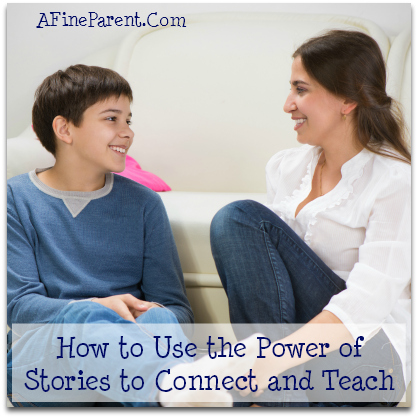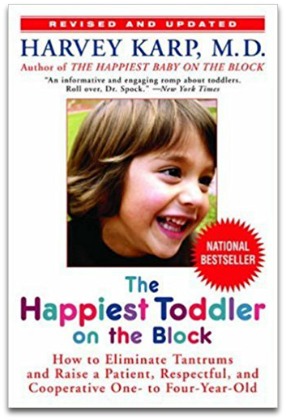 Gathered around a fire, a mother and child talk in quiet voices.
Gathered around a fire, a mother and child talk in quiet voices.
The flames leap as the mother tells the child stories of ancestors, faraway lands, and fantastic situations. Drowsy, the child falls asleep, her head on her mother’s lap.
This could be a scene from 10,000 years ago or 10 days ago.
Storytelling is a core part of what makes us human.
And yet, it’s not a tool parents use often — or are taught how to use — when talking to our kids.
This is unfortunate because storytelling is a powerful way we can communicate values, empathize with our children, show our support for them, and have fun.
Storytelling works whether your child is a tiny infant, just learning to recognize the sound of your voice, or a hardened teenager who spends much of their time trying to block you out.
The Benefits of Storytelling
Storytelling is an essential part of our fabric, and offers a whole range of benefits that other forms of communication lack.
Teach Values
As any parent who has tried lecturing, knows, children often ignore the message. Stories are an amazing way to pass on values, without hitting kids over the head with them.
Family stories are particularly effective, showing kids how their relatives have thrived in good times and persevered despite difficult ones. Research shows that kids who have a strong grasp on their family’s story are more likely to be emotionally resilient. They can pick up the psychological tools from these stories to get through challenging situations.
Personally, the stories I heard growing up about my great-grandfather biking hundreds of miles in the early 1900s instilled a sense that, I could do anything with hard work, and a sense of adventure.
Even the simplest tales can teach children what to do in a particular situation.
 For toddlers, Dr. Harvey Karp, author of the bestseller The Happiest Toddler on the Block, recommends telling straightforward stories that sneak values in via the ‘side door’ of children’s minds. For good examples of how to create a story about common preschool issues, watch a few episodes of Daniel Tiger’s Neighborhood or read a few Berenstain Bears stories!
For toddlers, Dr. Harvey Karp, author of the bestseller The Happiest Toddler on the Block, recommends telling straightforward stories that sneak values in via the ‘side door’ of children’s minds. For good examples of how to create a story about common preschool issues, watch a few episodes of Daniel Tiger’s Neighborhood or read a few Berenstain Bears stories!
As kids get older, you can build on these storytelling skills by attempting to use more complex storytelling structures involving irony, dilemmas, intrigue, and drama.
Teach Acceptance
Stories can teach children acceptance by helping them relate to people who are very different from them.
It can be difficult to put ourselves in the position of a desperate immigrant or refugee, but knowing the story of my grandmother immigrating to America when she was only three made that experience real for me.
Even fictional stories about kids with diverse backgrounds can help children relate to real-life people with those experiences.
Empathize and Connect
As a kid, it’s easy to believe that your parents will never understand what you are going through. After all, adults often don’t struggle—at least not publicly—with the same things we did as children.
One way to show that we empathize is by telling our own personal stories. Recalling a time that you went through a comparable experience or had similar feelings can help you relate and provide advice without being preachy.
For example, when my young son was afraid of swimming in the ocean, I listened to and validated his fears. I then told him about how, when I took trapeze classes, I was both thrilled and terrified.
Offer a Positive Narrative for Their Lives
 Perhaps most important are the stories we tell about our children.
Perhaps most important are the stories we tell about our children.
People frequently follow self-fulfilling prophecies, where we meet the expectations that people have of us, even if they’re false or unjustified. When we tell the same story about our kid over and over again, it reinforces their self-image. Even if that story isn’t representative of them as a person originally, they’ll start to feel it is and act accordingly.
Telling positive stories about our children can strengthen our relationship with them, and avoid putting up barriers that harmful stories can build.
In addition to the stories we tell about our kids’ past actions, there’s also space for the fictional and fantastic. My husband and I tell our older son all sorts of ridiculous stories starting with “Once upon a time, there was a boy named…” From there, one of us spins a tale, frequently involving outlandish adventures.
These made-up stories communicate to our son that we think he is kind, clever, and courageous, just like his story doppelgänger.
Use Stories to Diffuse Tension
As parents, we’ve all had times when our children drive us bonkers. There are times that we do the same to them!
Fortunately, stories can provide a common ground in even the most difficult times. When you’re angry at young children, telling a story about a fictional character can temporarily take your mind off of the issue and keep you from yelling.
If you can make the character learn the lesson that you’re trying to teach your child, you may even inspire some cooperation from them
For older children, recalling a funny family story or a time when you felt proud of them can ease the tension just a little bit.
Have Fun
Telling stories together can be just plain fun!
Collaborative storytelling between parents and children, and where everyone is contributing to a story, offers a unique time to bond and reinforce connection.
How to Tell and Share Stories with Your Children
 While everyone has stories to tell, not everyone is a natural-born storyteller. Fortunately, we don’t need to make up stories whole-cloth.
While everyone has stories to tell, not everyone is a natural-born storyteller. Fortunately, we don’t need to make up stories whole-cloth.
Family and personal stories are both the easiest to tell and some of the most powerful. The article How to Forge a Strong Family Using Good Old Family Stories talks about how to effectively develop and tell your family stories to your children.
Original stories can also play an important role, especially for young children. Making up stories may be particularly important if your family story is traumatic or you don’t know of any existing stories relevant to the situation.
Historical and news-based stories are another option, especially for older children who may deem themselves “too old” for simple fiction ones.
However, coming up with stories – especially on-the-fly – can be difficult if you have no experience with theater or improvisation.
1. Think about the types of stories you love to hear and tell.
They can be books, family stories, stories from your own life, historical stories, or stories in the news. Think about why you love them – is it the sense of adventure, the love story, the strength of the characters? What values do these stories encompass that you want to pass on to your kids?
For younger children, fictional stories may resonate more. Older children may relate more to stories of real-life heroes, whether in the past or present.
Having a few stories in your “back pocket” that resonate with you can enable you to reference them as conversation starters, allowing you to connect and subtly share with your kids what values mean the most to you.
Also, think about what stories you currently tell about your children, both to them and other people. Do they communicate what you want them to say about your child’s character?
2. Find opportunities to engage in storytelling with your child.
This can be before bedtime, through puppet shows, or just waiting in line.
In fact, some of the most beloved literature came from parents telling their children stories in their downtime. The book Watership Down started from stories that author Richard Adams told his daughters during car rides. Similarly, the Wizard of Oz books originated from tales that L. Frank Baum created for his children.
 As you tell the story, think about the aspects of stories you love and the values you want to express. While little kids enjoy stories in which not much happens, the best stories have characters with strong personalities and a conflict that they have to overcome. Most conflicts occur when a character wants something, but some circumstance—another character or a situation—prevents them from getting what they want.
As you tell the story, think about the aspects of stories you love and the values you want to express. While little kids enjoy stories in which not much happens, the best stories have characters with strong personalities and a conflict that they have to overcome. Most conflicts occur when a character wants something, but some circumstance—another character or a situation—prevents them from getting what they want.
If you are having difficulty coming up with stories, play off of existing ones! There are no rules saying that you need to write an award-winning novel. Even though I’m a professional writer, I still use existing characters and plots when I tell my son stories.
By using existing characters from books, movies, or television shows, you can tap into your and your child’s shared knowledge of that character.
I use this tactic a lot when putting on puppet shows, as we have a full array of Sesame Street characters. Coming up with scenarios where Bert and Ernie have a disagreement is a lot easier than if I had to do the same thing with completely original characters.
Revising fairy tales goes one step further by already having a set storyline in place. Because there are so many versions of fairy tales over the centuries and cultures, feel free to shift them to meet your needs and values.
In my version of Cinderella, the prince loves talking to her all night long rather than valuing her beauty. In the end, she just moves to the palace to become part of the court to get away from her mean family, with no mention of marriage.
Older children are more likely to relate to non-fiction stories and less likely to want stories from scratch. Stories of historical figures, especially those who had exciting or inspiring lives, may resonate.
I know as a teenager, I was inspired by the story of Nellie Bly, a journalist who committed herself to an insane asylum in 1887 to expose their horrible conditions. A Mighty Girl lists a number of books about amazing women who can be role models for both boys and girls.
Similarly, the news itself may provide potent stories for discussion. Political figures and pop culture icons provide colorful characters and plenty of conflict!
3. Teach your children how to tell their own stories.
 By telling their own stories, children can better understand their experiences and process their feelings. Research has shown that when parents use open-ended questions and elaborate on a past event with children, the children can better discuss and interpret their emotions afterwards.
By telling their own stories, children can better understand their experiences and process their feelings. Research has shown that when parents use open-ended questions and elaborate on a past event with children, the children can better discuss and interpret their emotions afterwards.
While children may not be ready to, or don’t want to share their stories with you, you can learn the basics of storytelling together. Rory’s Story Cubes and eBoo’s Tell Me a Story Cards both offer built-in characters, topics, and scenarios.
For older kids, the game of Story in the Round is perfect for a family game night. Each person has a few minutes to write a section of a story on a lined piece of paper. They then pass the sheet of paper to the next person, with it folded down so that everything but the last line is hidden. The paper goes around to all of the participants before the last person reads the whole thing. You’re unlikely to tell many deep or value-laden stories this way, but it’s a lot of fun!
 The 2-Minute Action Plan for Fine Parents
The 2-Minute Action Plan for Fine Parents
For our quick contemplation questions today, consider these –
- What stories do you remember your parents telling you, about your relatives and yourself? How did they make you feel?
- What stories do you tell about your children now and how do you think they make them feel?
- How can stories from your past relate to what your children have been going through lately?
- How can you adopt some of your favorite characters or simple stories to communicate the values you believe in?
The Ongoing Action Plan for Fine Parents
Find one opportunity to use a story with your child when you might lecture or otherwise offer advice. For younger children, you may want to use a fictional story. For older children, family, personal or other real-life stories are likely to have more resonance. See how they react! If they’re anything like my kids, the more you tell stories, the more they’ll ask for them.
Afterwards, try to find an opportunity to tell a story collaboratively. You can use one of the tools mentioned above. Or you can tell a family story that the children have heard before to a third party who has never heard it. You may be surprised how well the kids remember it!
Fabulous post i highly recommend it to others must read it.
Could you give me ideas of stories that an eleven and a half year old boy would enjoy.
Many thanks
Clare Lumsden
Eleven-years-old is generally regarded as “middle grade,” so look for books with that label. Because my kids are very young, I’m not as up-to-date on that level as I am picture books. GoodReads has several lists of recommended middle grade books (https://www.goodreads.com/list/tag/tween) and the New York Times has a select few recommendations at the bottom of their excellent “How to Raise a Reader” article (https://www.nytimes.com/guides/books/how-to-raise-a-reader).
Nice article, would you kindly list number of stories that teach children values.
It really depends on what kind of values you want to teach! A big value of mine is respect and celebration for diversity, so I like books that highlight children different from us. Other values include kindness, persistence, and exploration. We especially like A Chair for My Mother and Last Stop on Market Street for teaching about diversity.
And of course, make up your own! As I mentioned in the article, I revise fairy tales to match my own values. For Cinderella, I had her and the prince become best friends and her move into the castle to get away from her abusive family.